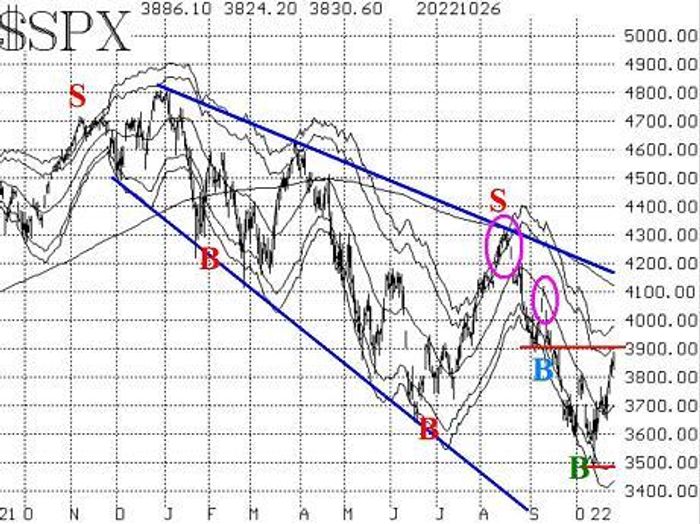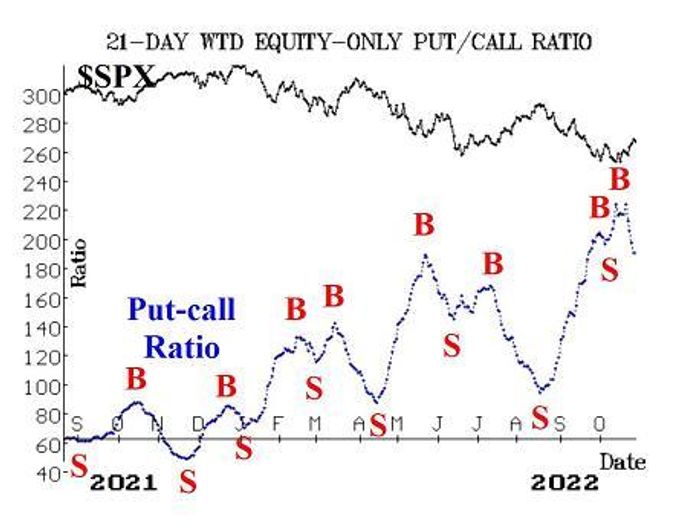The stock market has broken through technical resistance, and as a result the rally is trying to extend itself.
Specifically, the S&P 500’s
SPX,
close above 3800 points was a strong technical move this week. As you’ll read below, this plays into a reliable seasonal trade that begins Thursday.
Anyway, this now means that a rough “W” has formed on the SPX chart, as you can see below, which targets a move to about 4000. There is resistance below that, at 3900, and that area stopped the rally yesterday, but as long as SPX continues to close above 3800, the rally may keep going.
Ultimately, the really strong resistance comes in the form of the 200-day moving average — currently at 4120 and declining — and the downtrend line of this bear market (note the thick blue lines, below).

Those downtrend lines still define this as a bear market, but rallies in those cycles can be strong — often strong enough to test the mettle of the bears, while lulling the bulls into a false sense of security. Regardless, the McMillan Volatility Band (MVB) buy signal from early October is still in place. Its target is the upper +4σ “modified Bollinger Band,” which is currently at 3980 and beginning to rise.
Equity-only put-call ratios have solidified their buy signals. Furthermore, those buy signals came from extremely oversold positions on their charts, which should make them strong. In addition, the total put-call ratio is on a buy signal as well. It has already fulfilled its target move of 100 SPX points upward, but as along as these three ratios are declining, that is bullish for stocks.


Breadth has finally improved as well, and both breadth oscillators are now on buy signals. There was another “90% up day” this week. In fact, the “stocks only” breadth oscillator is already in overbought territory, but that is a good thing when SPX is at the beginning of a new move upward.
There has been a little improvement in the number of new highs on the NYSE, but not enough yet to generate a buy signal from this still-bearish indicator.
The CBOE Volatility Index
VIX,
continues to decline slowly. As a result, the “spike peak” buy signal is still in effect, and we are going to tighten the stop on that position (see the follow-up section). Even though VIX is still in the high 20s, it is beginning to decline enough to approach the rising 200-day moving average of VIX. If VIX closes below the 200-day for two consecutive days, that would cancel out the current trend of VIX sell signal. The 200-day MA of VIX is at roughly 26.50 and rising.

Note that a cancellation of the trend of VIX sell signal is not a buy signal. The buy signal would require that the 20-day MA of VIX also cross below the 200-day MA, and that is going to take some time to accomplish.
The construct of volatility derivatives has improved a little, although there is still some nervousness in option pricing regarding next week’s FOMC meeting Nov. 2. The term structure of the VIX futures slopes slightly upward for the first three months and is then rather jumbled after that. That is modestly bullish for stocks.
In summary, we are still maintaining a “core” bearish position for now but have traded several other positions around that as indicators have generated confirmed buy signals. We continue to recommend that approach.
New recommendation: Seasonal buy signal
This is one of the most reliable and profitable seasonal trades in our arsenal. A seasonal trade is one based on the calendar, not on any price or market action.
In this system, we buy “the market” — SPX — at the close of trading on October 27th and sell at the close of trading on November 2nd. (There are modifications if those dates fall on weekends.)
When we first used the trade, in 1997, we back-tested it through 1978. It had worked every year in that time frame. Now its track record is no longer perfect.
In the past 36 years that the system has been active, it has made money 31 times, using SPX prices as a basis. In reality, since we buy options, a couple of those years have shown small losses due to time decay or a decrease in volatility.
However you want to slice it, this is a profitable trading system. People often try to figure out why a seasonal trade works. In this case, it originally had to do with the fact that many mutual funds close their annual books at the end of October. So, even though they might have sold earlier in the month when the market was taking its “usual” October beating, they bought at the end of the month to avoid showing too much cash on their balance sheets at their fiscal year-end.
We have mentioned before that October is the “bear killer,” which means there have been some nasty declines earlier in October, but by the end of the month the market is rolling higher. That might be another factor why the system works, because anyone who sold earlier in the month might not want to show too much cash in their accounts by the end of the month.
At the close of trading on Thursday, October 27th,
Buy 2 SPY Nov (11th) at-the-money calls
and Sell 2 SPY Nov (11th) calls with a striking price 15 points higher.
Once the position is established, if the SPDR S&P 500 ETF Trust
SPY,
trades at the higher strike at any time, then roll up both sides of the spread by 15 points, staying in the Nov (11th) expiration. Exit the entire position at the close of trading on Wednesday, November 2nd.
New recommendation: Kimberly-Clark
A new buy signal has been generated by the weighted put-call chart for Kimberly Clark
KMB,
Buy 2 KMB Jan (20th) 120 calls
At a price of 5.20 or less.
KMB: 120.07 Jan (20th) call: 4.90 bid, offered at 5.20

Follow-up action
All stops are mental closing stops unless otherwise noted.
We are using a “standard” rolling procedure for our SPY spreads: in any vertical bull or bear spread, if the underlying hits the short strike, then roll the entire spread. That would be roll up in the case of a call bull spread, or roll down in the case of a bear put spread. Stay in the same expiration, and keep the distance between the strikes the same unless otherwise instructed.
Long 1 SPY Nov (18th) 352 put and Short 1 SPY Nov (18th) 325 put: this is our “core” bearish position. Previously, it was rolled down three times. Continue to hold without a stop.
Expiring: Long 1 SPY Oct (28th) 391 and Long 1 SPY Oct (28th) 366 put: this started out as the long 391 straddle; then we rolled the Oct (28th) 391 put down to the Oct (28th) 366 put. Sell the position now, if you can.
Expiring: Long 1 SPY Oct (28th) 352 put and Short 1 SPY Oct (28th) 327 put: this spread was bought in line with the trend of VIX sell signal and was rolled down. Now replace it with the following: Buy 1 SPY Nov (18th) 352 put and sell 1 SPY Nov (18th) 328 put. Stop yourself out if VIX closes below 26.50 for two consecutive days.
Long 1 SPY Nov (18th) 376 call and Short 1 SPY Nov (18th) 396 call: this is the new MVB buy signal, which was established on the morning of October 4th. This trade’s target is for SPX to trade at the upper, +4σ Band. The stop for this position would be if SPX were to close back below the -4σ Band.
Long 5 HLIT Nov (18th) 12.5 calls: raise thetrailing stop at to 14.20.
Long 1 SPY Nov (18th) 367 call and Short 1 SPY Nov (18th) 387 call: this spread was bought in line with the latest VIX “spike peak” buy signal, which was confirmed on Monday, October 17th. Stop yourself out if VIX closes at least 3.00 points higher over any 1-, 2-, or 3-day period (using closing prices). Otherwise, we will hold for 22 trading days (about a month).
Long 300 KLXE: set a closing, trailing stop at 11.80.Long 2 WRK Jan (20th) 32.5 calls: we will hold as long as the weighted put-call ratio remains on a buy signal.
Send questions to: [email protected].
Lawrence G. McMillan is president of McMillan Analysis, a registered investment and commodity trading advisor. McMillan may hold positions in securities recommended in this report, both personally and in client accounts. He is an experienced trader and money manager and is the author of the best-selling book, Options as a Strategic Investment. www.optionstrategist.com
Disclaimer: ©McMillan Analysis Corporation is registered with the SEC as an investment advisor and with the CFTC as a commodity trading advisor. The information in this newsletter has been carefully compiled from sources believed to be reliable, but accuracy and completeness are not guaranteed. The officers or directors of McMillan Analysis Corporation, or accounts managed by such persons may have positions in the securities recommended in the advisory.
